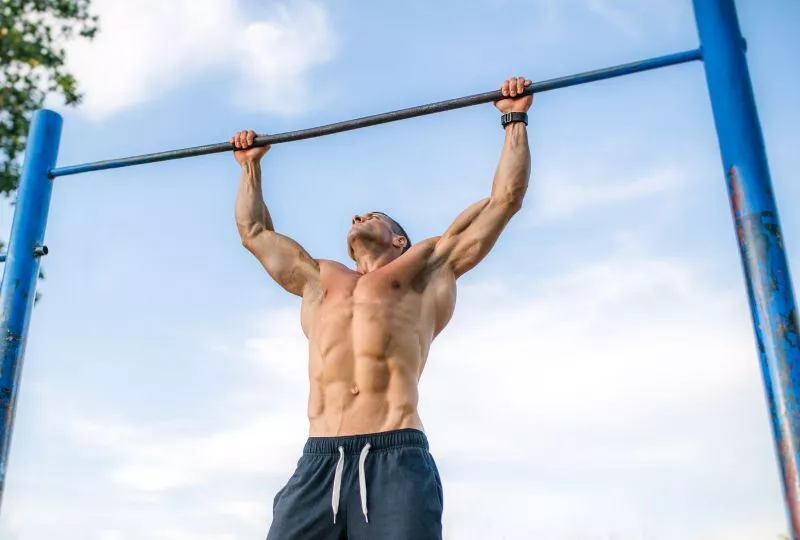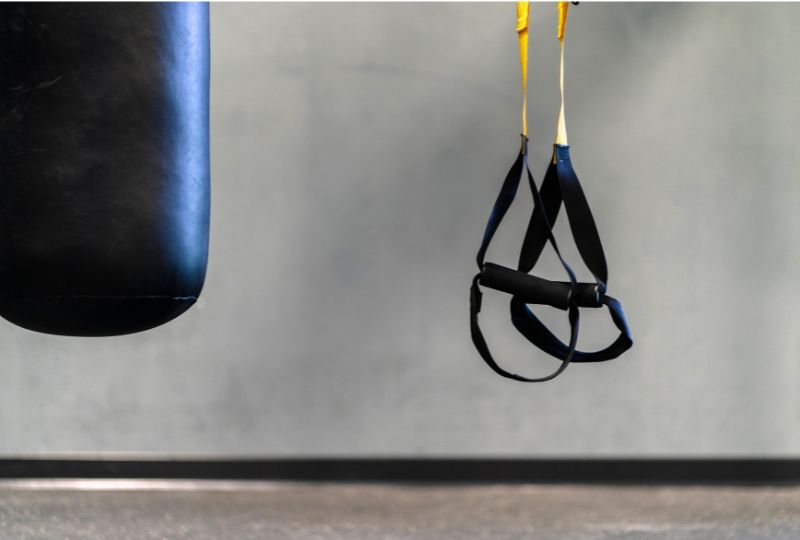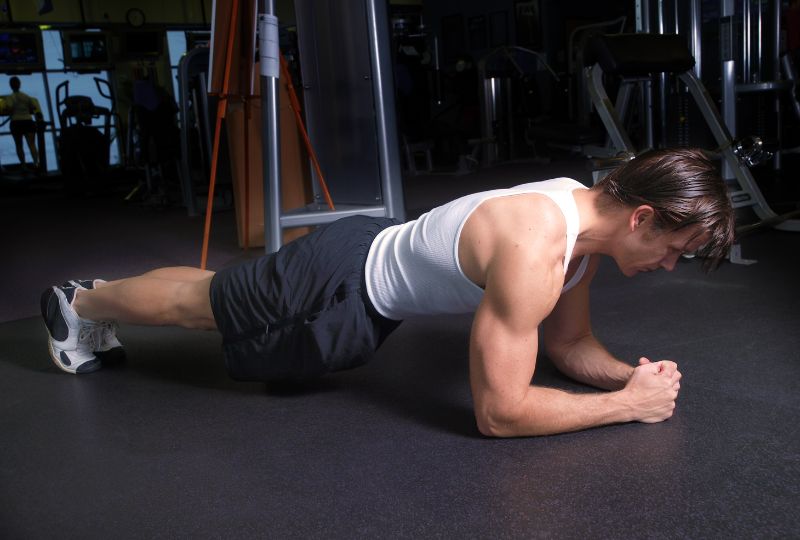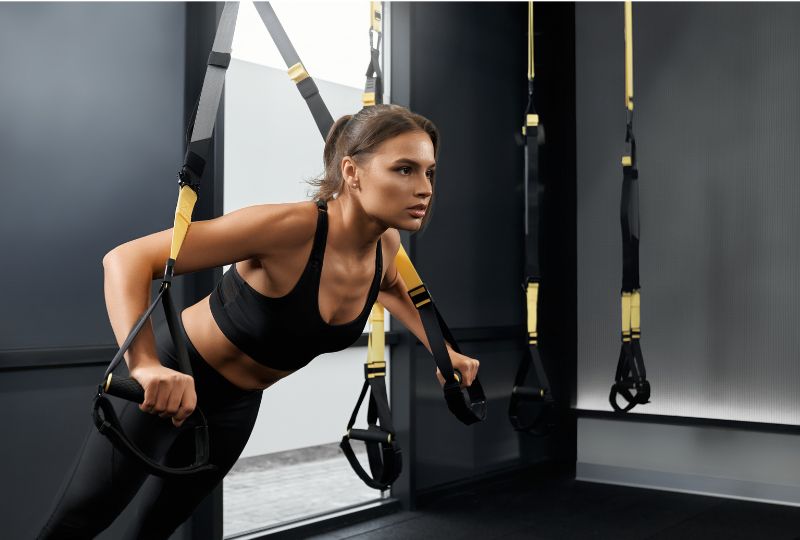This post may contain affiliate links at no additional cost to you. As an Amazon Associate I earn from qualifying purchases. Click to view our full disclosure.
What's inside
Calisthenics has grown more popular in recent years as an alternative to hauling weights in the gym.
Flashy fitness videos abound online, featuring a range of awesome-looking moves and tricks done by lean, strong athletes.
From a humble method of fitness training done from school gyms to military PT, calisthenics has broadened into its own genre of fitness.
For some of those watching these impressive displays, the discipline can seem hard to get into. Even simple exercises such as pull-ups can seem out of reach for beginners.
This article is a comprehensive guide for you to get started in the world of calisthenics training.
We’ll provide all the info you need regarding equipment, exercises, and how to make a plan.
There are example programs for every level, from complete beginner to the advanced athlete looking for a bodyweight-based challenge.
What is a calisthenics workout plan?

A calisthenics workout consists of exercises performed using body weight for resistance. There’s no need for external equipment.
Calisthenics training provides a method for building functional strength, muscle endurance, coordination, and flexibility.
It’s also cost-effective and time-efficient, making it one of the most accessible forms of resistance training.
A typical calisthenics program features exercises such as push-ups, chin-ups, squats, and many more, which will be featured in this guide.
Importantly, a calisthenics workout plan should be tailored to the individual. The program can look quite different for people with different needs.
Factors That May Affect a Calisthenics Workout Plan
Related: Calisthenic Shoulder Workout
Gender
While calisthenics is a great way to train for guys and girls, there are differences that may need to be accounted for in programming.
General differences in body length and body size lead to variation in factors such as pulling strength, grip strength, and vertical jump height.
These elements certainly won’t stop any male or female trainee from starting a calisthenics program, it just may require particular starting levels for each.
Training Level
Also known as training age or experience, training level can make calisthenics more difficult for some than others.
For young or new trainees, jumping straight into more difficult bodyweight exercises can seem impossible.
Again, calisthenics can be adjusted to accommodate a person of any ability level.
Training Goals
Calisthenics can be modified to reach all sorts of fitness goals.
From aerobic conditioning and fat loss to muscle gain and more, calisthenics is a viable option for almost any training goal.
That being said, it may not be the only way when it comes to particular goals such as muscle growth. Calisthenics can certainly be used, but it’s not necessarily the best way, at least on its own.
Whether calisthenics makes up your whole program or just part of it, it is definitely a functional and useful way to reach your goals.
General Health Status
Calisthenics has several unique elements that can make it challenging for some individuals.
Those with musculoskeletal injuries, chronic pain, or other health conditions may need to adjust their program to suit their situation.
Who is a calisthenics workout plan for?

The great thing about calisthenics is that anyone can do it.
While a newbie might not be rocking a 360 muscle up in a matter of weeks, there is a level for every person to start at.
Calisthenics training is arguably one of the most useful forms of fitness. While not everyone needs to do exclusively calisthenics, learning to master your own bodyweight is a skill everyone should be at least proficient in.
Plus, with no need for equipment or a gym, it’s perfect for those who need a quick option.
From young trainees building their first push-ups to older adults keeping themselves strong and independent, calisthenics is a skill for life.
Who cannot do a calisthenics workout plan?
While calisthenics is an excellent niche of fitness training, it might not necessarily be the best option in every case.
Bodyweight exercises can be included in any program but a workout plan based exclusively on calisthenics isn’t always optimal.
Because body weight is the resistance, some people may need to use other, more scalable exercises for certain muscles.
In cases of injury, disability, or other pain or chronic health conditions, calisthenics may need to be accompanied by other forms of training.
That being said, calisthenics is a highly functional form of activity to be worked in wherever possible.
The Best Equipment for a Calisthenics Workout

Pull-Up Bar
If you could only choose one piece of equipment for a complete calisthenics program, the pull-up bar would be it.
Because calisthenics relies on the body as the weight, the pulling muscles of the back and arms require an anchor point.
Calisthenics uses closed-chain upper-body exercises, fixing the hands to a set point and moving the body through space.
The pull-up bar allows you to perform many variations that will fully develop your back and arms.
Parallettes
Parallettes are a useful and versatile piece of equipment for a calisthenics program.
They allow for a more comfortable grip for those who find leaning on their wrists on the ground uncomfortable.
They can be used for many exercises, such as push-ups, dips, and L-sits, and can be moved around easily or taken when traveling.
Olympic Rings
Olympic rings are a great tool for those who want to get more advanced in their calisthenics training.
The rings allow for the hand and wrist to move and rotate throughout the range of motion of an exercise.
They also accommodate advanced variations of moves like muscle ups and other tough gymnastics exercises.
Weight Vest
This is another essential purchase for anyone looking to progress their calisthenics training.
A weight vest can turn your body into a muscle-building machine and can save having to find ever more difficult exercises to keep the gains coming.
A weight vest allows you to add small and gradual amounts of weight to exercises, which lets you be more consistent and gradual with progressions.
Suspension Handles
An alternative to Olympic rings, suspension trainers such as the popular TRX are an excellent, portable calisthenics tool.
Light-weight and packable, suspension trainers can be attached to any door frame, tree branch, or pull-up bar you can find.
The range of unique exercises that can be done with these devices is vast, so try one out if you want more options.
Gloves
With a lot of calisthenics exercises being done holding bars, rings, and handles, the hands can get a workout of their own.
A good pair of gloves can protect the skin of the fingers and palms, help strengthen the grip, and keep you swinging for longer.
What are the most common calisthenics exercises?

Push-Ups
The king of calisthenics exercises, the push-up is used from gym class to boot camp.
It’s a versatile compound exercise that works the entire chest, anterior shoulder, triceps, and core.
Push-ups can be done anytime, anywhere, and are a reliable way to keep your pushing strength and endurance up to scratch.
Pull-Ups/Chin-Ups
Pull-ups are a standard of upper body strength. If you can perform one or more pull-ups, you are at a certain level of strength many people don’t have.
While pull-ups are difficult and seem impossible to many, they can certainly be achieved with the right progression plan and consistent work.
Pull-ups do for the back, biceps, and abs what the push-up does for the anterior muscles.
If you could only do a single back exercise, consider making it the pull-up.
Squats
One of the most functional exercises out there, the squat is a complete lower body strengthener.
Working the quads, glutes, hamstrings, and core, the squat requires dozens of major muscles to work together.
Squatting translates to so many daily activities that it’s almost impossible to get through a normal day without it.
This makes the squat and its many variations a must-include in any calisthenics program.
Dips
Dips are another great chest developer for those with access to a set of parallettes or bars.
Dips are also effective at building strength and size in the push muscles when combined with a weight vest or belt to gradually add resistance.
Dips are similar to the pull-up in that while many people can’t do them, they are definitely a goal to work toward in a calisthenics workout plan.
Crunches
While crunches have fallen from the top as the go-to abs exercise, they are still certainly a good option when done with good technique.
Recruiting the upper rectus abdominis muscles to flex the trunk, crunches are a good starting point to develop the ‘six-pack’ muscles and strengthen the core.
Crunches need to be learned properly to avoid straining the lower back or neck when performing them.
They are also best combined with other abs exercises, which we’ll cover in later sections.
Plank
Finally, the plank is a go-to for testing and developing core strength and endurance.
Having a strong plank is a foundation that can help develop strength in any other exercise.
As the bridge between the lower and upper body, the core should be strengthened as much as possible to avoid losing energy during exercises.
Becoming proficient in this exercise translates to more reps in many of the exercises listed here.
Expect to see this exercise in many of the example calisthenics workout plans below.
The Benefits of a Calisthenics Workout Plan

Versatile
Calisthenics workout programs can be done with little or no equipment, making it the most versatile form of exercise out there.
Try calisthenics at home, in the office, at the park, and on vacation.
The only trouble is that you’ll have no excuses to miss a workout!
Time-Efficient
A calisthenics workout plan can save you time.
Not only can a good calisthenics session be done in a short time, but being able to work out at home means you save time getting to and from the gym as well.
You can also save time having to set up equipment or waiting for someone else to finish using a machine.
Scaleable
Calisthenics exercises can seem difficult, but for every advanced exercise, there are many regressions for any fitness level.
You can scale any advanced calisthenics skill back so it can be done by even the most beginner level trainee.
This makes calisthenics a great option for any skill level, as there’s always a new challenge to conquer.
Functional
Calisthenics movements use your body as the resistance. Getting good at moving your body through space is super valuable in everyday life.
While picking up heavy weights is great, you are less likely to use this than by learning how to move yourself.
Climbing, running, jumping, and pushing yourself up are all invaluable tools to be able to perform (and feel) young, athletic, and prepared for anything.
What are the most common calisthenics movements?

Horizontal Pull
The horizontal pull involves pulling the hands toward the chest.
The movements of a horizontal pull are shoulder extension, horizontal extension, and elbow flexion.
Example exercises include the suspended row, inverted row, or door frame row.
Horizontal Push
This is any exercise that involves pushing the arms out in front of the body.
Movements here include shoulder flexion and elbow extension.
Example exercises are the push-up, suspended push-up, or any other movement pushing yourself up off the ground.
Vertical Pull
The vertical pull is used to pull yourself up to a surface, such as climbing a fence or ledge.
Movements include shoulder adduction or extension, elbow flexion, and isometric contraction of the core muscles.
Example exercises are the chin-up, pull-up, and the many variations of these.
Vertical Push
A vertical push involves raising the arms to an overhead position.
In terms of calisthenics, this is done with the body in an inverted position.
Body movements include shoulder flexion and abduction as well as elbow extension.
Calisthenics exercises with a vertical push include handstand push-ups, pike push-ups, and more.
Squat
As mentioned, the squat is one of the most functional movements that should be trained in any gym program.
The movements of the squat are flexion and extension at the hip, knee, and ankle joints to lower down and then extend back up.
Squatting is done anytime we sit down or stand up from the ground, a seat, bed, couch, or even from the car or the toilet.
Hinge
Hinging at the hip is another fundamental movement pattern.
While typically performed with exercises such as deadlifts, the movement can also be done using calisthenics.
A hip hinge involves flexion at the hip, either from bringing the trunk forward or the thighs up toward the abdomen.
Calisthenics examples of hip hinges include reverse crunches, hanging leg raises, and L-sits.
Isometric Holds
In addition to the many dynamic calisthenics exercises, isometric or static holds are also a big part of this discipline.
The ability to hold the body in difficult positions is one of the more impressive displays of calisthenic strength.
Well-known isometric holds in calisthenics include the plank, horse-stance, the L-sit, front and back lever, and planche positions.
At Home Calisthenics Workout Plan: No-Equipment Exercises

The first program we have for you requires zero equipment: none at all.
It can be done at home, on your lunch break, or outdoors on a nice day.
This program is aimed at a beginner level, but you’ll be able to swap out the exercises for harder variations using the table further below.
With a quick workout time of 30 minutes, this program is a great place to start your calisthenics training.
Monday
Warm-up: General warm-up consisting of five minutes of arm circles forward and back, standing twists, and leg swings forward and side.
| Exercise | Sets x Reps | Rest |
| Push up | 3×15-20 | 30-60 sec |
| Doorway row | 3×15-20 | 30-60 sec |
| Squat | 3×15-20 | 30-60 sec |
| Double crunch | 3×15-20 | 30-60 sec |
| Jumping jacks | 3×60 sec | 30-60 sec |
Estimated Workout Duration: 30 mins (including warm-up)
Tuesday
Rest or moderate cardio for 30 minutes.
Wednesday
Warm-up: Five minutes of arm circles forward and back, standing twists, leg swings forward and side.
| Exercise | Sets x Reps | Rest |
| Bench dip | 3×15-20 | 30-60 sec |
| Supermans | 3×15-20 | 30-60 sec |
| Calf raise | 3×15-20 | 30-60 sec |
| Plank | 3×60 sec | 30-60 sec |
| High knees | 3×60 sec | 30-60 sec |
Estimated Workout Duration: 30 mins (including warm-up)
Thursday
Rest or moderate cardio for 30 minutes.
Friday
Warm-up: Arm circles forward and back, standing twists, leg swings forward and side for approximately five minutes.
| Exercise | Sets x Reps | Rest |
| Pike push-up | 3×15-20 | 30-60 sec |
| Doorway row | 3×15-20 | 30-60 sec |
| Glute bridge | 3×15-20 | 30-60 sec |
| Bicycle crunch | 3×15-20 | 30-60 sec |
| Burpees | 3×60 sec | 30-60 sec |
Estimated Workout Duration: 30 mins (including warm-up)
Saturday
Rest or 30 minutes of cardio.
Sunday
Rest day
Bodyweight Calisthenics Workout Plan PDF (No Equipment)
The Best Beginner Calisthenics Workout Plan
Next, we have a beginner program that incorporates some basic equipment to allow for better development of the back muscles in particular.
This is another three-day program, training the full body in each session.
Each workout also includes some cardio conditioning work, which can be scaled up or down depending on your goals.
If you don’t have a pull-up bar, you can do a DIY with a sturdy handle between two chairs for exercises such as the inverted row.
You could also add a fourth day of training once you’re used to the program – just ensure your recovery is sufficient.
Monday
Warm-up: Five minutes of arm circles forward and back, standing twists, leg swings forward and side.
| Exercise | Sets x Reps | Rest |
| Wall push-up | 3×15-20 | 30-60 sec |
| Doorway row | 3×15-20 | 30-60 sec |
| Squat | 3×15-20 | 30-60 sec |
| Standing elbow to knee | 3×15-20 | 30-60 sec |
| Walk | 10-20 mins | – |
Estimated Workout Duration: 30-40 mins (including warm-up)
Tuesday
Rest/moderate cardio 30 mins
Wednesday
Warm-up: General warm-up 5 minutes, arm circles forward and back, standing twists, leg swings forward and side.
| Exercise | Sets x Reps | Rest |
| Knee push-up | 3×15-20 | 30-60 sec |
| Suspended row (high) | 3×15-20 | 30-60 sec |
| Glute bridge | 3×15-20 | 30-60 sec |
| Crunches | 3×15-20 | 30-60 sec |
| High knee march | 3×60 sec | 30-60 sec |
Estimated Workout Duration: 30 mins (including warm-up)
Thursday
Rest or 30 minutes of moderate cardio.
Friday
Warm-up: General warm-up 5 mins, arm circles forward and back, standing twists, leg swings forward and side.
| Exercise | Sets x Reps | Rest |
| Bench dip | 3×15-20 | 30-60 sec |
| Suspended row (high) | 3×15-20 | 30-60 sec |
| Reverse lunge | 3×15-20 | 30-60 sec |
| Reverse crunches | 3×15-20 | 30-60 sec |
| Hill walk | 10-20 mins | – |
Estimated Workout Duration: 30-40 mins (including warm-up)
Saturday
Rest/moderate cardio 30 mins
Sunday
Rest day
Beginner Calisthenics Workout Plan PDF
The Best Intermediate Calisthenics Workout Plan

Once you’re ready to move on from the beginner level, this program will introduce continued stimulus to grow stronger.
With slightly more difficult exercises and higher volume, the workouts are still only up to 45 minutes in duration.
This program is a four-day, upper/lower body split. It consists of two upper-body sessions, and two legs and core sessions, hitting each muscle group twice per week.
This program will build an impressive level of bodyweight strength and control for the average gym-goer.
Again, substitute the high-intensity or steady-state cardio work according to your specific needs.
Monday
Warm-up: General warm-up 5 mins, arm circles forward and back, standing twists.
| Exercise | Sets x Reps | Rest |
| Push-up | 3-4×8-12 | 60 sec |
| Suspended row (low) | 3-4×8-12 | 60 sec |
| Pike push-up | 3-4×8-12 | 60 sec |
| Inverted row | 3-4×8-12 | 60 sec |
| High knees | 5×60 sec | 30 sec |
Estimated Workout Duration: 30-45 mins (including warm-up)
Tuesday
Warm-up: General warm-up 5 mins, standing twists, leg swings forward and side.
| Exercise | Sets x Reps | Rest |
| Squat | 3-4×8-12 | 60 sec |
| Bicycle crunch | 3-4×8-12 | 60 sec |
| Calf raise | 3-4×8-12 | 60 sec |
| Plank | 3xMAX | 60 sec |
| Jog/run | 10-20 mins | – |
Estimated Workout Duration: 40-50 mins (including warm-up)
Wednesday
Rest/moderate cardio 30 mins
Thursday
Warm-up: 5 mins arm circles forward and back, standing twists.
| Exercise | Sets x Reps | Rest |
| Suspended push-up | 3-4×8-12 | 60 sec |
| Underhand chin-up | 3-4×8-12 | 60 sec |
| Bench dip | 3-4×8-12 | 60 sec |
| Suspended row (high) | 3-4×8-12 | 60 sec |
| Mountain climbers | 5×60 sec | 30 sec |
Estimated Workout Duration: 30-45 mins (including warm-up)
Friday
Warm-up: General warm-up 5 mins, standing twists, leg swings forward and side.
| Exercise | Sets x Reps | Rest |
| Reverse lunge | 3-4×8-12 | 60 sec |
| Double crunch | 3-4×8-12 | 60 sec |
| Jump squat | 3-4×8-12 | 60 sec |
| Bird dog | 3-4×8-12 | 60 sec |
| Jog/run | 10-20 mins | – |
Estimated Workout Duration: 40-50 mins (including warm-up)
Saturday
Rest/moderate cardio 30 mins
Sunday
Rest day
Intermediate Calisthenics Workout Plan PDF
The Best Advanced Calisthenics Workout Plan

Finally, we have an advanced-level calisthenics workout plan for those looking to really impress with their calisthenic ability.
This program involves six total sessions per week, made up of two rounds of a PPL (push/pull/legs) split.
This program requires more time and consistency than the others, so go for it if you’re feeling motivated.
This advanced workout will get you building up to moves like the handstand push-up, muscle up and pistol squat.
Take a look at these tutorials on these advanced exercises, ensuring you work on technique as you build strength:
Handstand push-up:
Muscle up:
Pistol squat:
Monday
Warm-up: General warm-up 5 mins, arm circles forward and back, standing twists, wrist circles each way, neck circles each way.
| Exercise | Sets x Reps | Rest |
| Handstand/handstand push-up | 3-4×60 sec/8-12 | 3 mins |
| Parallel dip | 3-4×8-12 | 60-90 sec |
| Diamond push-up | 3-4xMAX | 30 sec |
| Plank | 3xMAX | 60 sec |
| Mountain climbers | 8×20 sec | 10 sec |
Estimated Workout Duration: 60 mins (including warm-up)
Tuesday
Warm-up: Five minutes of arm circles forward and back, standing twists, wrist circles each way, neck circles each way.
| Exercise | Sets x Reps | Rest |
| Muscle up/Wide pull-up | 3-4xMAX | 3 mins |
| Underhand chin-up | 3-4×3-6 | 3 mins |
| Inverted row | 3-4×8-12 | 60 sec |
| Side plank | 3-4xMAX | 30 sec |
| Burpees | 8×20 sec | 10 sec |
Estimated Workout Duration: 60 mins (including warm-up)
Wednesday
Warm-up: Five minutes of standing twists, leg swings forward and side, ankle circles each way.
| Exercise | Sets x Reps | Rest |
| Shrimp/pistol squat | 3-4×3-6 | 3 mins |
| Jump squat | 3-4×8-12 | 60-90 sec |
| Jump split squat | 3-4×8-12 | 60-90 sec |
| Toes to bar | 3-4xMAX | 30 sec |
| Hill sprints/sprints | 8x20m | Walk down/back |
Estimated Workout Duration: 60 mins (including warm-up)
Thursday
Warm-up: Five minutes of arm circles forward and back, standing twists, wrist circles each way, neck circles each way.
| Exercise | Sets x Reps | Rest |
| Handstand/handstand push-up | 3-4×60 sec/8-12 | 3 mins |
| Parallel dip | 3-4×8-12 | 60-90 sec |
| Diamond push-up | 3-4xMAX | 30 sec |
| Plank | 3xMAX | 60 sec |
| Mountain climbers | 8×20 sec | 10 sec |
Estimated Workout Duration: 60 mins (including warm-up)
Friday
Warm-up: General warm-up 5 minutes, arm circles forward and back, standing twists, wrist circles each way, neck circles each way.
| Exercise | Sets x Reps | Rest |
| Muscle up/Wide pull-up | 3-4xMAX | 3 mins |
| Underhand chin-up | 3-4×3-6 | 3 mins |
| Inverted row | 3-4×8-12 | 60 sec |
| Side plank | 3-4xMAX | 30 sec |
| Burpees | 8×20 sec | 10 sec |
Estimated Workout Duration: 60 mins (including warm-up)
Saturday
Warm-up: Five minutes standing twists, leg swings forward and side, ankle circles each way.
| Exercise | Sets x Reps | Rest |
| Shrimp/pistol squat | 3-4×3-6 | 3 mins |
| Jump squat | 3-4×8-12 | 60-90 sec |
| Jump split squat | 3-4×8-12 | 60-90 sec |
| Toes to bar | 3-4xMAX | 30 sec |
| Hill sprints/sprints | 8x20m | Walk down/back |
Estimated Workout Duration: 60 mins (including warm-up)
Sunday
Rest day
Advanced Calisthenics Workout Plan PDF
Calisthenics Progression Chart and Programming Guide
Related: Should You Do 100 Jumping Jacks A Day?
Once you’re in a good routine with one of the workouts above, you can swap out the exercises as they become easier.
If you can comfortably reach the required repetitions of an exercise, either add weight with a weight vest or swap the move out for a more challenging one.
For example, in the intermediate program, if you can easily do four sets of 12 push-ups, add weight to a weight vest, or use a harder alternative like the pike or diamond push-up.
The table below shows beginner (green), intermediate (yellow), and advanced (orange) level calisthenics exercises.
There are dozens more, so once you master these, you can research other exercises to try.
| Push | Pull | Legs | Core | Conditioning |
| Bench/wall push-up | Doorway row | Glute bridge | Standing elbow to knee | Walk |
| Knee push-up | Suspended row (high) | Squat | Crunches | High knee march |
| Push-up | Inverted row | Calf raise | Reverse crunches | Hill walk |
| Bench dip | Suspended row (low) | Reverse lunge | Bird dog | Jog/run |
| Suspended push-up | Underhand chin-up | Side lunge | Knee plank | Jumping jacks |
| Pike push-up | Neutral chin-up | Bulgarian split squat | Double crunch | High knees |
| Diamond push-up | Pull-up | Jump squat | Bicycle crunch | Mountain climbers |
| Parallel dip | Wide pull-up | Jump split squat | Plank | Burpees |
| Handstand | Muscle up | Shrimp squat | Side plank | Sprints |
| Handstand push-up | One arm chin-up | Pistol squat | Toes to bar | Hill sprints |
Also. check out this quick key below to determine which set and rep ranges suit your goal the best:
| Muscle Endurance | Muscle Growth | Strength | Conditioning | |
| Sets x Reps | 3×15-20 | 3-5×8-12 | 3-5×3-6 | 3-5×20-60 sec |
| Rest | 30 sec | 60-90 sec | 3-5 min | 0-30 sec |
You can apply any of these ranges to the programs above to further tailor them to your needs.
Common Reasons for Unsuccessful Calisthenics Workout Plans
Over-Reliance On Equipment
One reason people don’t succeed with calisthenics is they think they can’t train without a range of fitness equipment.
The best thing about calisthenics is that you don’t need equipment at all, you just need to know the right exercises.
While some of the training tools mentioned above can definitely enhance a calisthenics workout program, working with what you have is more important.
Exercise Selection
Many people try certain calisthenics exercises and write them off as too difficult or advanced.
What they don’t realize is that every exercise and movement in calisthenics has many levels to it, with regressions and progressions for any fitness level.
For example, a vertical pull can be as easy as a doorway row, or as advanced as a muscle-up or one-arm pull-up.
Progressive Overload
Another mistake is that people don’t progress consistently in their calisthenics program.
They start with certain exercises and stick with them long after they have become too easy.
Even though progression takes a bit more creativity with calisthenics, it can still be done and is critical to continuing gains.
Lack of Recovery
Calisthenics is tough training, and with that comes an extra layer of importance on recovering properly.
Just because many calisthenics exercises are bodyweight, it doesn’t mean the muscles don’t need time and rest to recover for the next session.
A good calisthenics program should include adequate rest days between sessions and between muscle groups.
You should also try to get sufficient sleep and perform any flexibility or soft-tissue work as needed.
Non-Optimized Nutrition
Finally, for some reason, nutrition and diet don’t get the attention they deserve much more commonly in calisthenics training.
Overall calorie consumption, protein intake, and pre and post-workout nutrition are just as important for calisthenics as for any gym-based program.
Make sure you take the time to dial in your nutrition to complement your calisthenics workout and get the best results possible.
Frequently Asked Questions
Can I build muscle with just calisthenics?
Your body can’t tell whether the resistance the muscles are working against is coming from a dumbbell, machine, or your bodyweight.
Calisthenics can be applied with the right training parameters to achieve a good level of muscle growth.
That being said, for long-term gains, calisthenics is best supplemented with external weight resistance training.
What are the 5 types of calisthenics?
Calisthenics comes in many forms. The common denominator is the use of body weight as the source of resistance.
The different types of calisthenics include things like:
- Military calisthenics: Push-ups, pull-ups, sit-ups, rope climbing, running
- Gymnastics: Static holds, Olympic rings, flipping
- Street calisthenics: Advanced dips, pull-ups, holds
- Parkour: Traversal, flips, jumps
- Bodybuilding calisthenics: Progressive overload, weighted vests
How many exercises should I do for calisthenics?
This depends on your goals for training. The number of exercises you should include in your workout depends on your overall training split.
The workouts in this guide consist of 4-5 exercises per session, both for a time-efficient workout and because this provides good volume per muscle group.
With a calisthenics workout plan, you can keep it as basic or as varied as you like.
The staple exercises are all you need for a great fitness foundation, with as many variations to moves as you could want.
How do you make a calisthenics plan?
Like any kind of workout program, a calisthenics plan should include exercises covering all major muscle groups, split between the number of sessions that work for you.
Use the exercises and parameters in this guide to get started with your foray into calisthenics.
As long as you have the right mix of exercises, volume, and frequency, you’ll reach your goals with consistent effort.
Closing Comments
So, what do you think about our guide to calisthenics workout plans?
Let us know what style of calisthenics you’re interested in – and which plan you want to try – in the comments.
If you know anyone interested in starting a calisthenics workout program, share this article with them as well.

